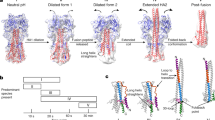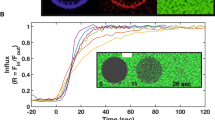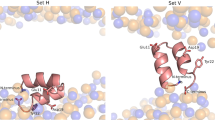Abstract
Influenza A virus haemagglutinin conformational change drives the membrane fusion of viral and endosomal membranes at low pH. Membrane fusion proceeds through an intermediate called hemifusion1,2. For viral fusion, the hemifusion structures are not determined3. Here, influenza virus-like particles4 carrying wild-type haemagglutinin or haemagglutinin hemifusion mutant G1S5 and liposome mixtures were studied at low pH by Volta phase plate cryo-electron tomography, which improves the signal-to-noise ratio close to focus. We determined two distinct hemifusion structures: a hemifusion diaphragm and a novel structure termed a ‘lipidic junction’. Liposomes with lipidic junctions were ruptured with membrane edges stabilized by haemagglutinin. The rupture frequency and hemifusion diaphragm diameter were not affected by G1S mutation, but decreased when the cholesterol level in the liposomes was close to physiological concentrations. We propose that haemagglutinin induces a merger between the viral and target membranes by one of two independent pathways: a rupture–insertion pathway leading to the lipidic junction and a hemifusion-stalk pathway leading to a fusion pore. The latter is relevant under the conditions of influenza virus infection of cells. Cholesterol concentration functions as a pathway switch because of its negative spontaneous curvature in the target bilayer, as determined by continuum analysis.
This is a preview of subscription content, access via your institution
Access options
Subscribe to this journal
Receive 12 digital issues and online access to articles
$119.00 per year
only $9.92 per issue
Buy this article
- Purchase on Springer Link
- Instant access to full article PDF
Prices may be subject to local taxes which are calculated during checkout




Similar content being viewed by others
References
Chernomordik, L. V., Zimmerberg, J. & Kozlov, M. M. Membranes of the world unite! J. Cell Biol. 175, 201–207 (2006).
Kemble, G. W., Danieli, T. & White, J. M. Lipid-anchored influenza hemagglutinin promotes hemifusion, not complete fusion. Cell 76, 383–391 (1994).
Harrison, S. C. Viral membrane fusion. Virology 479–480C, 498–507 (2015).
Chen, B. J., Leser, G. P., Morita, E. & Lamb, R. A. Influenza virus hemagglutinin and neuraminidase, but not the matrix protein, are required for assembly and budding of plasmid-derived virus-like particles. J. Virol. 81, 7111–7123 (2007).
Qiao, H., Armstrong, R. T., Melikyan, G. B., Cohen, F. S. & White, J. M. A specific point mutant at position 1 of the influenza hemagglutinin fusion peptide displays a hemifusion phenotype. Mol. Biol. Cell 10, 2759–2769 (1999).
Chlanda, P. et al. Structural analysis of the roles of influenza A virus membrane-associated proteins in assembly and morphology. J. Virol. 89, 8957–8966 (2015).
Harris, A. et al. Influenza virus pleiomorphy characterized by cryoelectron tomography. Proc. Natl Acad. Sci. USA 103, 19123–19127 (2006).
Bonnafous, P. et al. Treatment of influenza virus with beta-propiolactone alters viral membrane fusion. Biochim. Biophys. Acta 1838, 355–363 (2014).
Lee, K. K. Architecture of a nascent viral fusion pore. EMBO J. 29, 1299–1311 (2010).
Maurer, U. E., Sodeik, B. & Grunewald, K. Native 3D intermediates of membrane fusion in herpes simplex virus 1 entry. Proc. Natl Acad. Sci. USA 105, 10559–10564 (2008).
Erickson, H. P. & Klug, A. Measurement and compensation of defocusing and aberrations by Fourier processing of electron micrographs. Phil. Trans. R. Soc. Lond. B 261, 105–118 (1971).
Danev, R., Buijsse, B., Khoshouei, M., Plitzko, J. M. & Baumeister, W. Volta potential phase plate for in-focus phase contrast transmission electron microscopy. Proc. Natl Acad. Sci. USA 111, 15635–15640 (2014).
Kozlovsky, Y. & Kozlov, M. M. Stalk model of membrane fusion: solution of energy crisis. Biophys. J. 82, 882–895 (2002).
Frolov, V. A., Dunina-Barkovskaya, A. Y., Samsonov, A. V. & Zimmerberg, J. Membrane permeability changes at early stages of influenza hemagglutinin-mediated fusion. Biophys. J. 85, 1725–1733 (2003).
Chernomordik, L. V. & Kozlov, M. M. Mechanics of membrane fusion. Nature Struct. Mol. Biol. 15, 675–683 (2008).
Ivanovic, T., Choi, J. L., Whelan, S. P., van Oijen, A. M. & Harrison, S. C. Influenza-virus membrane fusion by cooperative fold-back of stochastically induced hemagglutinin intermediates. eLife 2, e00333 (2013).
Danieli, T., Pelletier, S. L., Henis, Y. I. & White, J. M. Membrane fusion mediated by the influenza virus hemagglutinin requires the concerted action of at least three hemagglutinin trimers. J. Cell Biol. 133, 559–569 (1996).
Kozlovsky, Y., Chernomordik, L. V. & Kozlov, M. M. Lipid intermediates in membrane fusion: formation, structure, and decay of hemifusion diaphragm. Biophys. J. 83, 2634–2651 (2002).
Needham, D. & Nunn, R. S. Elastic deformation and failure of lipid bilayer membranes containing cholesterol. Biophys. J. 58, 997–1009 (1990).
Zimmerberg, J. & Gawrisch, K. The physical chemistry of biological membranes. Nature Chem. Biol. 2, 564–567 (2006).
Hao, M. et al. Vesicular and non-vesicular sterol transport in living cells. The endocytic recycling compartment is a major sterol storage organelle. J. Biol. Chem. 277, 609–617 (2002).
Van Meer, G., Voelker, D. R. & Feigenson, G. W. Membrane lipids: where they are and how they behave. Nature Rev. Mol. Cell Biol. 9, 112–124 (2008).
Kobayashi, T. et al. Late endosomal membranes rich in lysobisphosphatidic acid regulate cholesterol transport. Nature Cell Biol. 1, 113–118 (1999).
Yang, S. T., Zaitseva, E., Chernomordik, L. V. & Melikov, K. Cell-penetrating peptide induces leaky fusion of liposomes containing late endosome-specific anionic lipid. Biophys. J. 99, 2525–2533 (2010).
Diao, J. et al. Synaptic proteins promote calcium-triggered fast transition from point contact to full fusion. eLife 1, e00109 (2012).
Kreutzberger, A. J., Kiessling, V. & Tamm, L. K. High cholesterol obviates a prolonged hemifusion intermediate in fast SNARE-mediated membrane fusion. Biophys. J. 109, 319–329 (2015).
Niwa, H., Yamamura, K. & Miyazaki, J. Efficient selection for high-expression transfectants with a novel eukaryotic vector. Gene 108, 193–199 (1991).
Ellens, H., Doxsey, S., Glenn, J. S. & White, J. M. Delivery of macromolecules into cells expressing a viral membrane fusion protein. Methods Cell Biol. 31, 155–178 (1989).
Fukuda, Y., Laugks, U., Lucic, V., Baumeister, W. & Danev, R. Electron cryotomography of vitrified cells with a Volta phase plate. J. Struct. Biol. 190, 143–154 (2015).
Kremer, J. R., Mastronarde, D. N. & McIntosh, J. R. Computer visualization of three-dimensional image data using IMOD. J. Struct. Biol. 116, 71–76 (1996).
Frangakis, A. S. & Hegerl, R. Noise reduction in electron tomographic reconstructions using nonlinear anisotropic diffusion. J. Struct. Biol. 135, 239–250 (2001).
Helfrich, W. Elastic properties of lipid bilayers: theory and possible experiments. Z. Naturforsch C 28, 693–703 (1973).
Nagle, J. F. & Tristram-Nagle, S. Structure of lipid bilayers. Biochim. Biophys. Acta 1469, 159–195 (2000).
Hamm, M. & Kozlov, M. M. Elastic energy of tilt and bending of fluid membranes. Eur. Phys. J. 3, 323–335 (2000).
Siegel, D. P. & Kozlov, M. M. The Gaussian curvature elastic modulus of N-monomethylated dioleoylphosphatidylethanolamine: relevance to membrane fusion and lipid phase behavior. Biophys. J. 87, 366–374 (2004).
Li, S. et al. pH-controlled two-step uncoating of influenza virus. Biophys. J. 106, 1447–1456 (2014).
Pan, J., Tristram-Nagle, S. & Nagle, J. F. Effect of cholesterol on structural and mechanical properties of membranes depends on lipid chain saturation. Phys. Rev. E 80, 021931 (2009).
Calder, L. J., Wasilewski, S., Berriman, J. A. & Rosenthal, P. B. Structural organization of a filamentous influenza A virus. Proc. Natl Acad. Sci. USA 107, 10685–10690 (2010).
Acknowledgements
The authors thank V. Nair for assistance with the Krios transmission electron microscope at Rocky Mountain Laboratories Microscopy Unit, National Institute of Allergy and Infectious Diseases, National Institutes of Health. The authors also thank L.-A. Carlson, L. Chernomordik, I. Morales and T. Reese for critical reading of the manuscript. This work was supported by the Division of Intramural Research of the Intramural Program of the National Institutes of Health.
Author information
Authors and Affiliations
Contributions
The project was planned by P.C., P.S.B. and J.Z. Experimental work was performed by P.C. and E.M. pCAGGS-M1 and pCAGGS-M2 constructs were generated by H.W. Cryo-electron microscopy and tomography was done by P.C., C.L.S. and E.R.F. Statistical analysis and image processing was performed by P.C. and P.S.B. Continuum analysis was carried out by R.J.R. and F.S.C. The manuscript was written by P.C., R.J.R., F.S.C., P.S.B. and J.Z. All authors assisted in editing the manuscript and contributed to data analysis.
Corresponding authors
Ethics declarations
Competing interests
The authors declare no competing financial interests.
Supplementary information
Supplementary Information
Supplementary Results, Figures 1–10, Tables 1–4, Video legends and References. (PDF 14180 kb)
Supplementary Video 1
Tomogram showing ‘Y’ (lipidic) junctions mediated by G1S VLP corresponding to Fig. 2b. Tomogram was acquired at defocus –5 μm without VPP and denoised using nonlinear anisotropic diffusion (NAD) filter with k value 10 and 10 iterations. Scale bar: 50 nm. (MOV 2721 kb)
Supplementary Video 2
Tomogram showing ‘Y’ (lipidic) junctions mediated by G1S VLP corresponding to Fig. 2c. Tomogram was acquired at defocus –1 μm with VPP and denoised using NAD filter with k value 10 and 10 iterations. Scale bar: 50 nm. (MOV 6384 kb)
Supplementary Video 3
Tomogram showing liposome and complete HD connected to the membrane of the G1S filamentous VLP from top (corresponding to Fig. 2e). Tomogram was acquired at defocus –1 μm with VPP. (MOV 907 kb)
Supplementary Video 4
Animated visualization of the isosurface of a spherical VLP and several liposomes at low pH shown in Figs 2c and 3a–d. Liposome marked by A corresponds to the liposome in Figs (MOV 6651 kb)
Supplementary Video 5
Tomogram showing ruptured liposomes and lipidic junctions with G1S filamentous VLP (corresponding to Fig. 3e). Tomogram was acquired at defocus –1 μm with VPP and denoised using the NAD filter with a k value of 1 for 10 iterations. (MOV 2543 kb)
Supplementary Video 6
Animated visualization of the isosurface of ruptured liposomes and lipidic junctions with G1S filamentous VLP (corresponding to Fig. 3e). Scale bar: 50 nm. (MOV 2901 kb)
Supplementary Video 7
Tomogram showing WT VLP and liposomes fusion product (FP) after complete fusion characteristic of areas of membrane free of influenza glycoproteins. Red arrows and marks sparsely distributed influenza glycoproteins and red line highlights the membrane harbouring influenza glycoproteins. The unmarked area is free of influenza glycoproteins. Scale bar: 50 nm. (MOV 11311 kb)
Rights and permissions
About this article
Cite this article
Chlanda, P., Mekhedov, E., Waters, H. et al. The hemifusion structure induced by influenza virus haemagglutinin is determined by physical properties of the target membranes. Nat Microbiol 1, 16050 (2016). https://doi.org/10.1038/nmicrobiol.2016.50
Received:
Accepted:
Published:
DOI: https://doi.org/10.1038/nmicrobiol.2016.50
This article is cited by
-
The local variation of the Gaussian modulus enables different pathways for fluid lipid vesicle fusion
Scientific Reports (2024)
-
Nonuniversal impact of cholesterol on membranes mobility, curvature sensing and elasticity
Nature Communications (2023)
-
Planar aggregation of the influenza viral fusion peptide alters membrane structure and hydration, promoting poration
Nature Communications (2022)
-
Recent Developments in Single-Virus Fusion Assay
The Journal of Membrane Biology (2022)
-
Lipid and Lipidation in Membrane Fusion
The Journal of Membrane Biology (2022)



